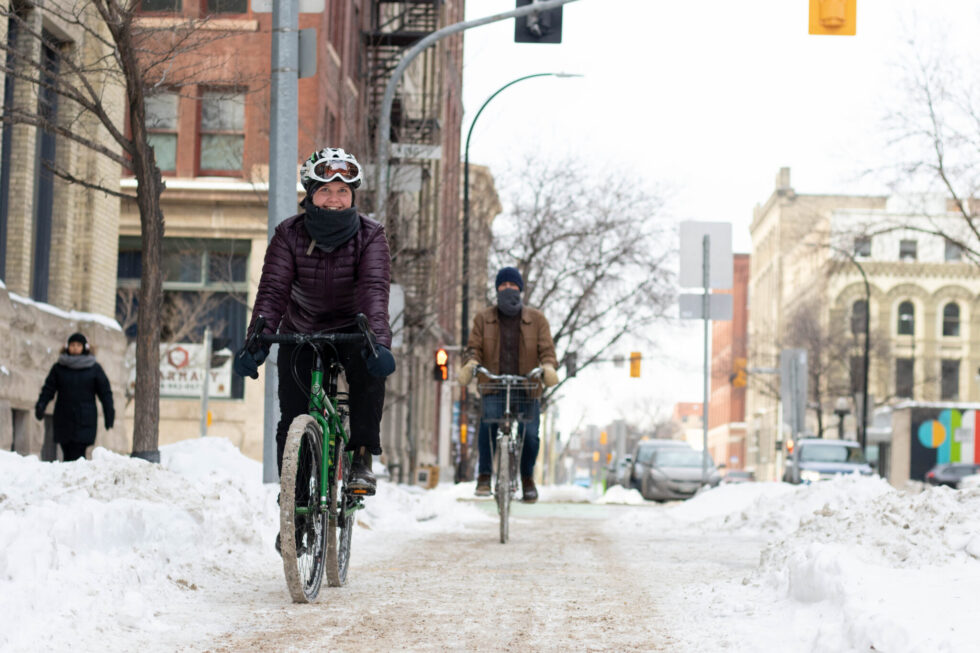As the snow falls and the temperatures drop, many cyclists put away their bikes for the season. We are here to tell you that cycling doesn’t have to be a seasonal sport! Cycling is for all-year-round commuting, transportation, and leisure – even in Manitoba.
Cycling through winter and navigating ice-covered streets can be challenging, but if you plan for the weather, have the right equipment, ensure regular maintenance and find your safe route, you can continue to enjoy cycling in all seasons.
Not for you? That’s ok! There are plenty of other ways to get around sustainably in the winter. Lace up your Sorels and walk to your destination, reduce your carbon footprint by carpooling with a group, or take public transit instead.
Still interested? Here are our tips to help you keep cycling through winter:
Plan your Route
You most likely have a set route for your summer cycling, but when you consider slippery conditions and road maintenance, you may need to re-think your route for winter cycling. Cities have varying priorities when it comes to snow clearing, so be sure that your route is being cleared in time for you to get where you need to go.
Safety
In all seasons, safety should be a top priority when cycling. In the winter months, there are unique conditions that require a little extra safety planning. Top safety concerns include traction, visibility, and unpredictable conditions.
- Equip your bike with LED lights on the front and rear, add a reflector and/or reflective tape, and wear bright clothing that provides reflection
- Consider packing extra gear, such as hats, mitts, socks, a flat tire change kit, bus fare, energy gels and anything else you may need in case of an emergency
- Use separated bike lanes when they are an option, try to maintain a safe distance from vehicles on the road, and adjust your cycling speed in accordance with weather conditions
- Try to avoid black ice by riding on grit, sand, or fresh snow whenever possible
Dress for the Conditions
If you’ve already made it through a few Manitoba winters, you probably have got dressing for winter activities down pat. The not-so-secret secret is layers. Once you get your body moving, you’ll be much warmer than you would be sitting in a frigid car waiting for the heat to kick in!
- Start with a perspiration wicking undergarment, an insulating layer, and a windproof, waterproof, and breathable outer shell
- Opt for lightweight materials to reduce bulk
- Keep your head and face protected with layers such as a balaclava, toque, mask, neck tube, goggles, and a helmet
- You can tape over the vents of your summer helmet or use a ski/snowboard helmet that provides more warmth
- Wear gloves or mittens that provide enough dexterity to operate your brakes and change your gears
- Wear warm socks (multiple pairs if necessary) or thermal shoe covers to keep the wind off your feet
Recommended Equipment
When it comes to cycling, the most notable piece of equipment is obviously, the bike. The types of bikes used to ride in the winter come in a wide range. Here are the things to consider when choosing that bike and additional equipment for your all-season cycling needs.
Winterizing your Bike
Many cyclists don’t have a separate bike to use during the winter season, so they opt to winterize their bike. There are easy steps you can take to avoid investing in a second bike for the winter.
- Slightly reduce your tire pressure
- Adjust your fenders to accommodate additional snow build up on your tires
- Clean and lube your bike before it snows
Additional Winterization
- Add studded tires to help with traction on black ice, and improve puncture resistance and rolling resistance
- Add knobby tires with a centre bead to provide traction on fresh snow, slush, and packed snow
- Consider getting wheels with sealed cartridge hubs to seal out water and grit
- Single speeding your bike helps to lessen maintenance requirements, as derailleurs require constant care and lubrication
If you’re investing in a winter-specific bike, fat bikes have become very popular for winter riding, or a mountain bike would also be sufficient for all-season riding.
Equipment Maintenance
During the winter, equipment requires more frequent tune-ups. An important part to any bike maintenance is the drivetrain, which consists of all the parts that help you push the bike along, such as; pedals, cranks, chainrings, chain, cogs, and derailleurs. In winter temperatures, cleaning the drivetrain is typically restricted to the use of a rag or brush.
- Using light bicycle lubricants works best in colder temperatures
- Lubricate liberally and regularly, be sure to wipe off excess lubricant to avoid the build-up of additional salt and sand
- Wipe off any apparent build-up, never use solvents to clean your chain
- Bicycles with multi-gear systems will require more frequent cleaning
- Brush away snow and ice from your brakes and drivetrain after each ride
- Wipe your bike down regularly to avoid any additional salt build-up
The winter may add some wear and tear to your ride, but with proper maintenance, a bike can last many seasons of winter fun!
Safe Infrastructure
Of course, you can be as prepared as you want, but the number one factor that will help you make that leap to try winter cycling is safe, well-maintained infrastructure. With your support, we are always working on advocating for infrastructure that allows Manitobans to continue getting around by bike, no matter the weather.
